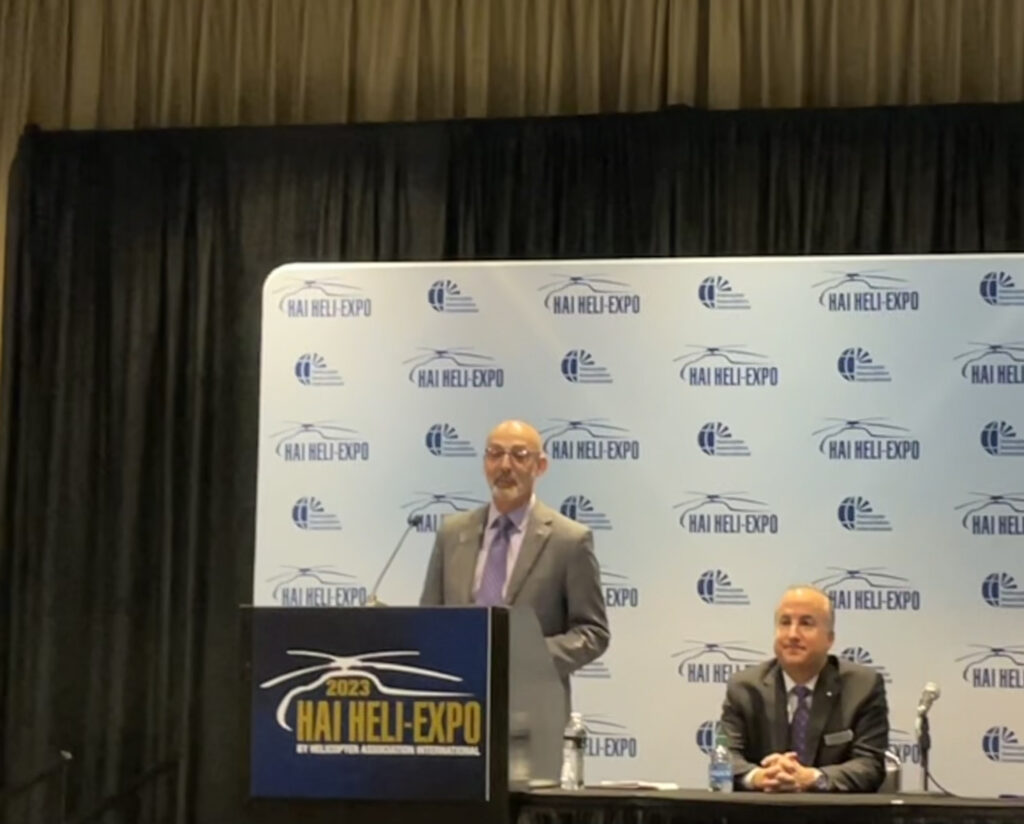
President Paul Lemmo and Vice President of Global Commercial and Military Systems Leon Silva spoke during a press conference at HAI Heli-Expo 2023 to share some updates from the past year as well as some of the innovations they see going forward.
Sikorsky Aircraft celebrated its 100th anniversary on March 5, just before the start of this year’s HAI Heli-Expo event in Atlanta. President Paul Lemmo and Vice President of Global Commercial and Military Systems Leon Silva spoke during a press conference to share some updates from the past year as well as some of the innovations they see going forward.
One of the highlights mentioned was that more than 3,000 lives were saved with Sikorsky aircraft in 2022. The company also delivered 95 helicopters last year across their commercial and military portfolio. Lemmo shared that he is most proud of the fact “that we had three of our platforms that were in development together that all went through successful Initial Operational Test and Evaluation, and achieved IOC—initial operational capability—with their respective services.”
These three platforms were the VH-92A, the CH-53K, and the Combat Rescue Helicopter. “The CH-53K lifted a Black Hawk that had been downed in the high-altitude mountains of California at about 12,000 feet,” Lemmo remarked. He also mentioned that the CH-53K successfully lifted an F35 helicopter.

The Combat Rescue Helicopter (Photo: Sikorsky)
The Combat Rescue Helicopter went through its IoT in mid-2022 and was declared IOC early fall. “I’m not sure how many helicopter companies can put two or three major programs through development simultaneously and achieve IOC,” Lemmo said. “That’s a pretty amazing accomplishment if you understand how complex these machines are, and the development that we go through.”
He commented that although they accomplished a great deal in the past year, they were disappointed in the decision on the Future Long-Range Assault Aircraft (FLRAA) program.
“We continue to push forward with X2—we believe that this delivers some revolutionary capability and speed, range, maneuverability, and survivability,” Lemmo said. “We think it’s a great fit for the Future Attack Reconnaissance Aircraft (FARA) program. We remain deeply involved in that competition.”
He noted that they continue to fly the S-97 Raider which provides value for further developments. “It’s a testament to an experimental aircraft that we’re still able to fly this aircraft,” he stated. “It serves as a testbed for all of our X2 activities. It’s 80% of the scale of our Raider X aircraft, so every time we fly this, whether it be for a customer demonstration, or an engineering test—of which we’re still doing many—it continues to build our confidence in the digital model that we have for Raider X.”
Raider X is 95% complete, he revealed, having been 92% complete as of last October. The team hopes to install the Improved Turbine Engine Program (ITEP) soon, and begin ground and flight testing this year.
The International Twin, a larger-scale concept than the Raider X, is a dual-engine based on X2 technology and is primarily intended for the international utility market at the moment. “We are working collaboratively with Leonardo on a study for the Italian government to see how X2 fits into their next-generation fast helicopter program and meets their requirements,” Lemmo added. “We’re also closely watching the next-generation rotorcraft capability that’s being developed by NATO. There’s a lot of studies going on that we’re participating in. We certainly think that that X2 fits very well with a number of the requirements that they have.”
Another recent achievement by Sikorsky is the delivery of 5,000 Hawk variants, which was celebrated in January. “This aircraft continues to thrive in the market,” Lemmo said. “In Australia, we recently were awarded a contract for 40 Black Hawks worth nearly $2 billion. Australia is in the process of tripling their Hawk population from 23 aircraft to 76.”

“The multi-mission UH-60M Black Hawk provides the Australian Army with critical capabilities that will strengthen Australia’s readiness, interoperability and security for decades to come.” – Paul Lemmo (Photo: Sikorsky)
“We’re also looking at putting a modular open systems architecture backbone on the aircraft and cockpit to take it into 21st-century warfare capabilities and be able to interoperate with future vertical lift aircraft,” explained Lemmo.
“We also were looking at [incorporating] a digital vehicle management system—think of that as a fly-by-wire capability—so that we can implement our matrix capability. We’ve seen that fly on a Blackhawk, and we know that the Army has interest in the contested logistics mission of potentially using some of those capabilities for an unmanned Black Hawk. There is a lot to come from the Black Hawk fleet from a modernization perspective, and we are continuing production both domestically and internationally.”